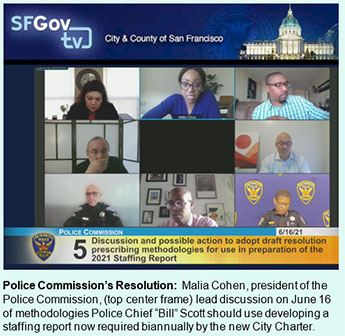 Printer-friendly PDF file
Printer-friendly PDF fileJuly 8, 2021
Reducing SFPD’s Bloated Sworn Police Officers
Police Commission Staffing Guidance to Chief Scott
by Patrick Monette-Shaw
On June 16, San Francisco’s Police Commission passed a Resolution prescribing methodologies Police Chief “Bill” Scott should use to prepare the Police Department’s 2021 staffing report required by the November 2020 “Prop. E” ballot measure that removed from the former City Charter the mandate to have a minimum of 1,971 sworn police officers in SFPD.
The Resolution specifying the methodologies to be used by Chief Scott passed unanimously by the five Commissioners present on June 16, given the absence of Police Commissioner Larry Yee.
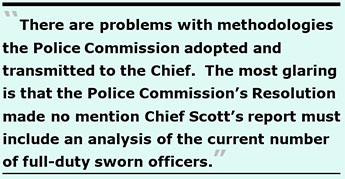 Unfortunately, there are problems with the methodologies the Police Commission adopted and transmitted to the Chief. The most glaring problem is that the Police Commission’s Resolution made no mention that Scott’s report must include an analysis of the current number of full-duty sworn officers. There are other shortcomings to the methodologies the Commission adopted.
Unfortunately, there are problems with the methodologies the Police Commission adopted and transmitted to the Chief. The most glaring problem is that the Police Commission’s Resolution made no mention that Scott’s report must include an analysis of the current number of full-duty sworn officers. There are other shortcomings to the methodologies the Commission adopted.
“Prop. E” required that the Police Commission adopt a policy by July 1 prescribing the methodologies the Chief may use in evaluating police staffing levels, and further requires the Police Commission to hold a public hearing regarding the Chief’s staffing report by December 31, 2021. The Commission directed Chief Scott to provide a verbal update during a public meeting of the Commission by August 31 on progress on developing his staffing report, and include any foreseen need to deviate from the methodologies the Commission directed he use.
The Westside Observer reported in June 2021 that during May and June San Francisco’s Board of Supervisors Budget and Appropriations Committee held hearings on each City Department’s proposed two-year budgets for Fiscal Year 2021–2022 and Fiscal Year 2022–2023.
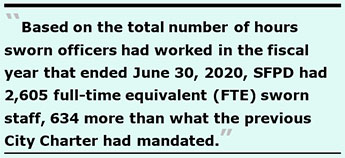 As we reported last June, Police Chief William Scott proposed to the Police Commission in February 2020 that police officer staffing beginning July 1, 2020 should be increased to 2,715 sworn officers — 744 more than the 1,971 sworn officers previously mandated as the minimum in the former City Charter. We also reported that based on the total number of hours sworn officers had worked during the fiscal year that ended on June 30, 2020 SFPD had 2,605 full-time equivalent (FTE) sworn staff based on the total number of regular- plus overtime-hours they had worked, 634 more than what the Charter had mandated.
As we reported last June, Police Chief William Scott proposed to the Police Commission in February 2020 that police officer staffing beginning July 1, 2020 should be increased to 2,715 sworn officers — 744 more than the 1,971 sworn officers previously mandated as the minimum in the former City Charter. We also reported that based on the total number of hours sworn officers had worked during the fiscal year that ended on June 30, 2020 SFPD had 2,605 full-time equivalent (FTE) sworn staff based on the total number of regular- plus overtime-hours they had worked, 634 more than what the Charter had mandated.
Finally, we noted in June that one red herring is the notion that reductions to SFPD sworn police officers must be done using a 1:1 ratio of replacing police officers with civilian counterparts.
Somewhat shocking — but not too surprising, given that the Board of Supervisors has not yet finished developing and adopting the City’s next two-year budget — news reports surfaced during June 2021 on ABC Channel 7 broadcasts that SFPD and the Mayor began claiming SFPD was facing staffing shortages of approximately 200 police officers. Some observers suspected the 200-officer shortage was rolled out hoping to affect outcomes of SFPD’s next budget award. The observers wondered whether San Francisco’s Police Officers Association (POA) was involved in the 200-officer shortage claim.
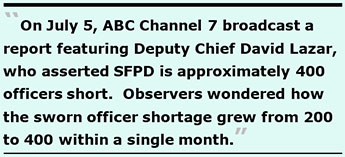 At about 5:20 p.m. on July 5, ABC Channel 7 broadcast a report about increased burglaries and robberies in the City. The broadcast featured Deputy Chief David Lazar, who suddenly asserted that SFPD is approximately 400 officers short. Those observers then wondered how the officer shortage grew from 200 to 400 within a single month.
At about 5:20 p.m. on July 5, ABC Channel 7 broadcast a report about increased burglaries and robberies in the City. The broadcast featured Deputy Chief David Lazar, who suddenly asserted that SFPD is approximately 400 officers short. Those observers then wondered how the officer shortage grew from 200 to 400 within a single month.
[An unverified rumor — not yet reported in, or verified by, the mainstream media — has surfaced that between 72 and 100 SFPD officers turned in their guns during June alone, decamping for other jurisdictions or opting to retire from City employment. It’s unclear if the rumor may also have originated from the POA. At this point it remains just a rumor.]
 Methodologies the Commission Approved
Methodologies the Commission Approved
Methodologies the Police Commission adopted in its June 16, 2021 Resolution direct Chief Scott to focus on four main areas of interest to the Commission:
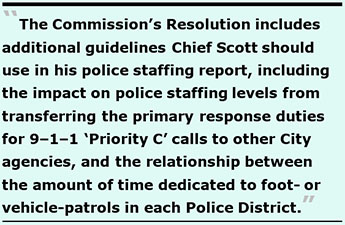 In addition, the Commission’s Resolution includes additional guidelines to be used in the police staffing report, including that the Chief must ensure his staffing analysis includes discussion of:
In addition, the Commission’s Resolution includes additional guidelines to be used in the police staffing report, including that the Chief must ensure his staffing analysis includes discussion of:
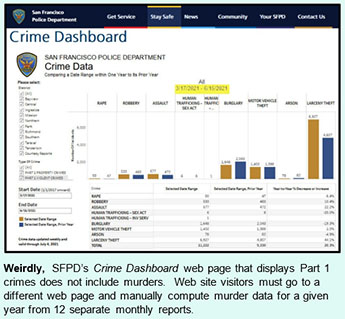 Problems With Police Commission’s Methodologies
Problems With Police Commission’s Methodologies
There are a number of problems with some of the methodologies the Police Commission laid out.
FBI UCR Part 1 Crimes
For the ratio-based methodologies, it’s curious why the Police Commission may only be concerned about UCR Part 1 crimes.
The FBI’s Uniform Crime Reporting (UCR) program collects official data about crime trends across the United States. The UCR is a nationwide, statistical effort of approximately 18,000 city, university and college, county, state, tribal, and federal law enforcement agencies that voluntarily report data on crimes brought to the attention of the FBI.
Part 1 crimes are collectively known as “Index” crimes because those crimes are considered quite serious, tend to be reported more reliably than others, and reports are taken directly by the police, not by a separate agency. Part 1 crimes are broken into two categories: Violent crimes and property crimes.
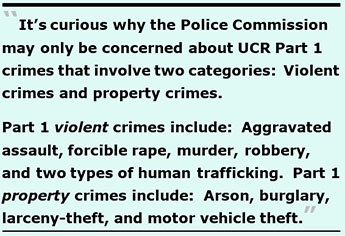 Part 1 violent crimes include: Aggravated assault, forcible rape, murder (including non-negligent manslaughter), robbery, human trafficking (commercial sex acts), and human trafficking (involuntary servitude). [Note: The two human trafficking offenses were added to the UCR in 2013.]
Part 1 violent crimes include: Aggravated assault, forcible rape, murder (including non-negligent manslaughter), robbery, human trafficking (commercial sex acts), and human trafficking (involuntary servitude). [Note: The two human trafficking offenses were added to the UCR in 2013.]
Part 1 property crimes include: Arson, burglary, larceny-theft, and motor vehicle theft.
Some observers suspect SFPD doesn’t want the public to easily access murder and homicides statistics. Indeed, SFPD’s Crime Dashboard website — which has a feature to easily display aggregated year-to-date crime data — does not include or display murders and homicides, as shown in the Crimes Dashboard for the period ending July 4, 2021. Instead, members of the public are forced to go to another website page for monthly “CompStat” (computer statistics) reports and manually compute murder data for a given year from 12 separate monthly reports.
The Police Commission should direct Chief Scott to include the homicide/murder data on the Crime Dashboard website, so members of the public don’t have to go to the CompStat web site to find monthly reports reporting the homicide data, and then have to compile annual homicide data manually.
 Table 1 illustrates SFPD’s Crime Dashboard comparing apples-to-apples periods during the COVID pandemic between March 17 and June 15, 2020 to the same post-COVID three-month period in 2021:
Table 1 illustrates SFPD’s Crime Dashboard comparing apples-to-apples periods during the COVID pandemic between March 17 and June 15, 2020 to the same post-COVID three-month period in 2021:
Table 1: SFPD Crime Dashboard, 3/17/20 – 6/15/20 vs. 3/17/21 – 6/15/21
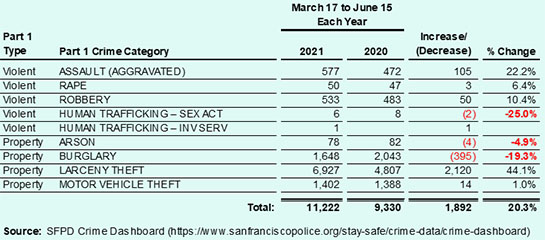
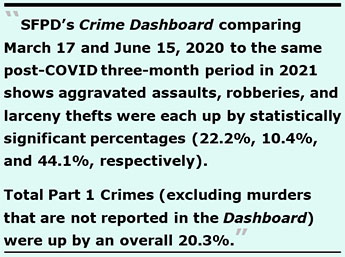 It’s clear aggravated assaults, robberies, and larceny thefts (including, but not limited to, shoplifting) were each up by statistically significant percentages (22.2%, 10.4%, and 44.1%, respectively) in 2021, and total Part 1 Crimes (excluding murders that are not reported in the Dashboard) were up by an overall 20.3%.
It’s clear aggravated assaults, robberies, and larceny thefts (including, but not limited to, shoplifting) were each up by statistically significant percentages (22.2%, 10.4%, and 44.1%, respectively) in 2021, and total Part 1 Crimes (excluding murders that are not reported in the Dashboard) were up by an overall 20.3%.
Indeed, the CompStat report for May 2021 shows that comparing May 2021 to May 2020 murders were up 100%, robberies were up 28%, aggravated assaults were up 20%, overall larceny thefts were up 49%, and thefts from vehicles were up 105%.
Before Bill Scott was hired as Police Chief, his predecessor’s reports contained sub-categories for each Part 1 crime category. For example, the CompStat report for November 2016 just before Scott became Chief included Robbery data broken out for sub-categories of robberies involving firearms, knives or other cutting instruments, other dangerous weapons, and strongarm robberies not involving a weapon. Similarly, the Burglary category reported sub-categories for forcible entries, unlawful entries without force, and attempted forcible entries.
But when former-Mayor Ed Lee appointed Scott as Police Chief in January 2017, the CompStat monthly report for January 2017 no longer reported any of the various sub-categories of data.
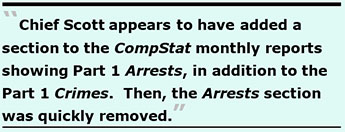 As well, Chief Scott appears to have added a section to the CompStat monthly reports showing Part 1 Arrests, in addition to the Part 1 Crimes in the January and February 2017 monthly reports. Then, the Arrests section was quickly removed from the March 2017 report and was no longer reported.
As well, Chief Scott appears to have added a section to the CompStat monthly reports showing Part 1 Arrests, in addition to the Part 1 Crimes in the January and February 2017 monthly reports. Then, the Arrests section was quickly removed from the March 2017 report and was no longer reported.
The Police Commission should also direct Chief Scott (and future Chiefs) to resume reporting the Arrests data, in addition to the Part 1 Crimes, to the CompStat monthly reports. Perhaps resuming public disclosure of Part 1 Arrests data might spur embattled District Attorney Chesa Boudin to actually prosecute those who are arrested, rather than let them off the hook and return them to the community to repeat their offenses.
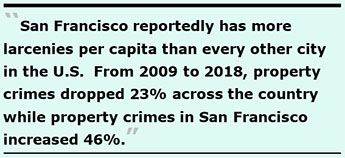 San Francisco reportedly has more larcenies per capita than every other city in the U.S. From 2009 to 2018, property crimes dropped 23% across the country while property crimes in San Francisco increased 46%, which represents a 66% point spread.
San Francisco reportedly has more larcenies per capita than every other city in the U.S. From 2009 to 2018, property crimes dropped 23% across the country while property crimes in San Francisco increased 46%, which represents a 66% point spread.
FBI UCR Part 2 Crimes
It’s curious that the Police Commission chose to exclude requiring Chief Scott to analyze the FBI’s Uniform Crime Reporting (UCR) system’s Part 2 crimes in developing staffing recommendations. The UCR system may only collect actual Arrest data for Part 2 crimes.
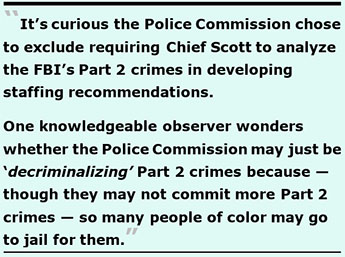 Part 2 crimes include: Simple assault, curfew offenses and loitering, embezzlement, forgery and counterfeiting, disorderly conduct, driving under the influence, drug offenses, fraud, gambling, liquor offenses, offenses against the family, prostitution, public drunkenness, runaways, sex offenses, stolen property, vandalism, vagrancy, and weapons offenses.
Part 2 crimes include: Simple assault, curfew offenses and loitering, embezzlement, forgery and counterfeiting, disorderly conduct, driving under the influence, drug offenses, fraud, gambling, liquor offenses, offenses against the family, prostitution, public drunkenness, runaways, sex offenses, stolen property, vandalism, vagrancy, and weapons offenses.
There is a pyramid of crimes. The ones at the bottom — Part 2 crimes — are considered to be the most venial crimes, but perhaps the most voluminous and which may occur far more frequently than Type I crimes. Observers note that SFPD doesn’t have the time, or political will, to tend to the “small stuff,” like Part 2 crimes. One knowledgeable observer wonders whether the Police Commission may just be “decriminalizing” Part 2 crimes because, though they may not commit more Part 2 crimes, so many people of color may go to jail for them.
It’s hard to believe there have been zero Part 2 crimes and arrests in San Francisco over the years. San Franciscans deserve to be told about the Part 2 data. The Police Commission should direct Chief Scott to begin reporting Part 2 crime data in CompStat monthly reports to provide the public with increased police accountability and transparency.
 Current Sworn Officer Staffing
Current Sworn Officer Staffing
Most concerning, the Police Commission failed to direct Chief Scott to take into consideration current staffing levels of sworn officers in SFPD using the number of full-time equivalent (FTE) officers currently on the City’s payroll.
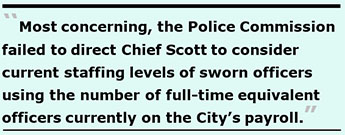 There are a number of ways of looking at the current levels of SFPD sworn officer staffing.
There are a number of ways of looking at the current levels of SFPD sworn officer staffing.
Table 2 presents the number of sworn officers on the City payroll for the past three fiscal years. It shows that as recently as June 30, 2020 the City had 194 more FTE officers than the actual 2,411 named sworn officers on the payroll (based on their regular hours plus overtime hours worked).
Table 2: Named Officers on City Payroll vs. Their Full-Time Equivalent Positions
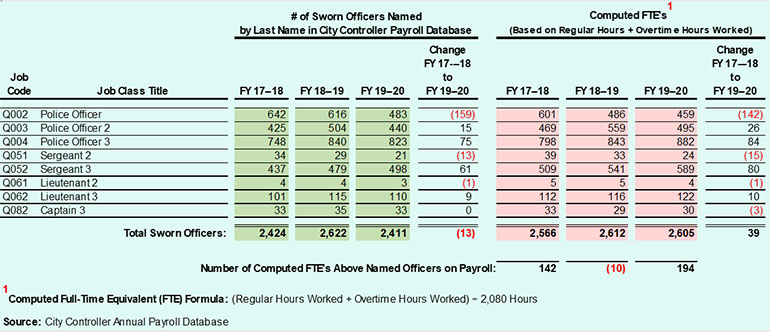
 Of note, Table 2 shows that in the three year period between July 1, 2017 and June 30, 2020 almost half — 46.4% — of the 194 extra FTE’s involved 90 “supervising” officers (80 additional Sergeant FTE’s and 10 additional Lieutenant FTE’s).
Of note, Table 2 shows that in the three year period between July 1, 2017 and June 30, 2020 almost half — 46.4% — of the 194 extra FTE’s involved 90 “supervising” officers (80 additional Sergeant FTE’s and 10 additional Lieutenant FTE’s).
Another way of looking at the current level of sworn officers is by comparing the computed FTE’s to the former City Charter and to other reports. Table 3 shows that before “Prop. E” passed in November 2020, the  previous Charter mandated that SFPD have a minimum of 1,971 sworn officers. But as of June 30, 2020 the 2,411 officers on the City payroll involved 634 more FTE officers than the 1,971 the former Charter had mandated.
previous Charter mandated that SFPD have a minimum of 1,971 sworn officers. But as of June 30, 2020 the 2,411 officers on the City payroll involved 634 more FTE officers than the 1,971 the former Charter had mandated.
Two other indicators paint a slightly different picture of excess sworn officers.
Table 3: Excess Officers: Actual vs. Previously Recommended Officers
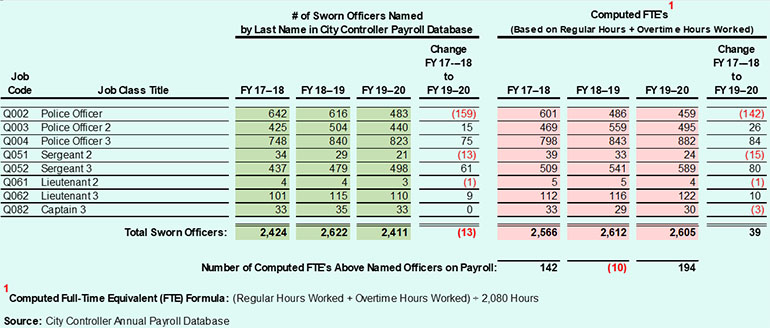
 One of the other indicators in Table 3 involved the Matrix Consulting Group’s recommendation in early 2020 to increase sworn officers to 2,107 FTE’s, ostensibly an increase above the 1,971 minimum sworn officers prescribed by the former City Charter. Matrix Consulting had been hired by the Police Commission to help analyze SFPD staffing needs.
One of the other indicators in Table 3 involved the Matrix Consulting Group’s recommendation in early 2020 to increase sworn officers to 2,107 FTE’s, ostensibly an increase above the 1,971 minimum sworn officers prescribed by the former City Charter. Matrix Consulting had been hired by the Police Commission to help analyze SFPD staffing needs. The other additional indicator in Table 3 is from the CompStat reports listing monthly Part 1 UCR crime statistics posted on SFPD’s web site. Weirdly, every monthly report going back five years to the last report former Police Chief Greg Suhr authored in April 2016 (and before) all show in the report header that SFPD had 2,217 sworn officers. [Perhaps Police Command staff overlooked ever adjusting the number of sworn officers displayed on the CompStat monthly reports, and perhaps no SFPD clerical staff ever pointed out this error.]
The other additional indicator in Table 3 is from the CompStat reports listing monthly Part 1 UCR crime statistics posted on SFPD’s web site. Weirdly, every monthly report going back five years to the last report former Police Chief Greg Suhr authored in April 2016 (and before) all show in the report header that SFPD had 2,217 sworn officers. [Perhaps Police Command staff overlooked ever adjusting the number of sworn officers displayed on the CompStat monthly reports, and perhaps no SFPD clerical staff ever pointed out this error.] Meanwhile, Table 4 below shows that over the last three fiscal years, the payroll costs (excluding fringe benefits) for the current sworn police officers — excluding Commanders, Assistant Chiefs, and Deputy Chiefs on SFPD’s Command Staff — grew by $36.3 million as of June 30, 2020.
Meanwhile, Table 4 below shows that over the last three fiscal years, the payroll costs (excluding fringe benefits) for the current sworn police officers — excluding Commanders, Assistant Chiefs, and Deputy Chiefs on SFPD’s Command Staff — grew by $36.3 million as of June 30, 2020.
Table 4: Historical Costs of Sworn Officers
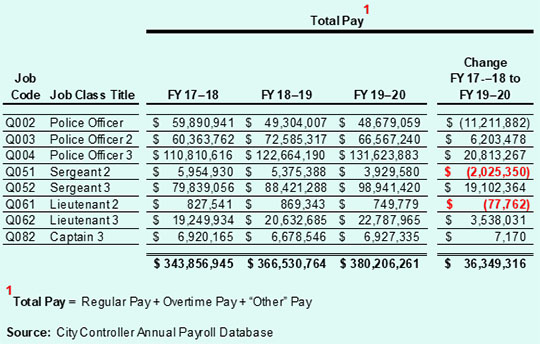
Span of Control
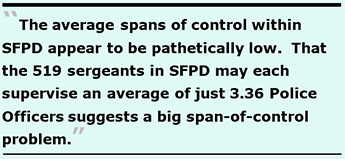 Law enforcement agencies typically use military style chains of command, with higher-ranking staff supervising the ranks just below them.
Law enforcement agencies typically use military style chains of command, with higher-ranking staff supervising the ranks just below them.
Based on a seat-of-the pants, quick-and-dirty analysis, the 2,411 named sworn police officer staff in the City Controller’s payroll database for the period ending June 30, 2020 the average spans of control within SFPD shown in Table 5 below appear to be pathetically low:
Table 5: Rough SFPD Spans of Control
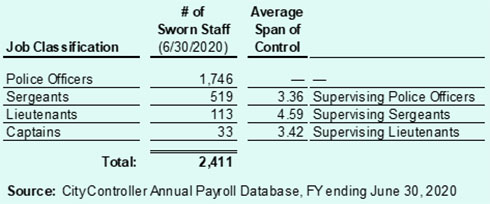
That the 519 sergeants in SFPD may each supervise an average of just 3.36 Police Officers suggests a big span-of-control problem. Clearly, the Police Commission should closely watch Chief Scott’s span-of-control analysis when he submits his recommended staffing report later in 2021.
 Current Staffing Redeployment
Current Staffing Redeployment
Although the Police Commission rightly noted Chief Scott needs to consider the potential impact of the Street Crisis Response Teams — that Mayor London Breed introduced about a year ago — when considering potential strategies for redeployment of sworn officers, the Commission made no mention that the Board of Supervisors’ Budget and Appropriations Committee is considering reallocation of Police budget dollars to an additional Compassionate Alternative Response Team (CART) program.
The Commission also failed to direct Chief Scott to consider redeployment or elimination of police officers assigned to SFPD’s Airport Division, given that the Budget and Appropriations Committee may also be considering replacing SFPD staffing at the Airport with staff from the Sheriff’s Department, instead.
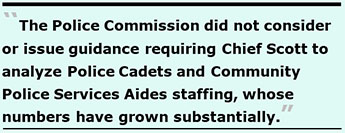 Finally, the Police Commission did not consider or issue guidance requiring Chief Scott to analyze Police Cadets and Community Police Services Aides staffing, whose numbers have grown substantially — particularly at the Airport — to handle such things as traffic control duties instead of sworn officers.
Finally, the Police Commission did not consider or issue guidance requiring Chief Scott to analyze Police Cadets and Community Police Services Aides staffing, whose numbers have grown substantially — particularly at the Airport — to handle such things as traffic control duties instead of sworn officers.
My reporting in September 2020 noted Community Police Services Aides are paraprofessionals who perform a variety of police-related duties for the San Francisco Police Department, including directing traffic, issuing citations for parking violations, processing complaints, and completing reports, among other duties.
 There has been a 97.2% change increase in Community Police Services Aides, from 145 in 2009 to 286 in FY 2019–2020. And there’s been a 139.5% change increase in total pay (excluding fringe benefits) for just the Police Services Aides — from $9.3 million in 2009 to $22.2 million ending June 30, 2019.
There has been a 97.2% change increase in Community Police Services Aides, from 145 in 2009 to 286 in FY 2019–2020. And there’s been a 139.5% change increase in total pay (excluding fringe benefits) for just the Police Services Aides — from $9.3 million in 2009 to $22.2 million ending June 30, 2019.
To the extent consideration is being given to transfer traffic control duties from sworn officers to civilians, the Police Commission should also consider whether those duties should also be transferred from Police Services Aides to civilians.
Civilianization
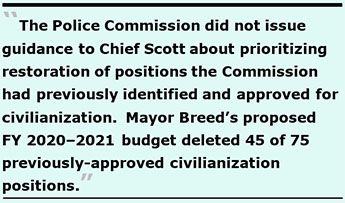 The Police Commission did not issue guidance to Chief Scott about prioritizing restoration of positions the Commission had previously identified and approved for civilianization in the initial FY 2021–2022 proposed budget. According to the Board of Supervisors’ Budget and Legislative Analyst’s May 12, 2021 report on Law Enforcement staffing, Mayor Breed’s proposed FY 2020–2021 budget deleted 45 of previously-approved 75 civilianization positions that were vacant, a loss of 30 positions that had been earmarked for civilianization.
The Police Commission did not issue guidance to Chief Scott about prioritizing restoration of positions the Commission had previously identified and approved for civilianization in the initial FY 2021–2022 proposed budget. According to the Board of Supervisors’ Budget and Legislative Analyst’s May 12, 2021 report on Law Enforcement staffing, Mayor Breed’s proposed FY 2020–2021 budget deleted 45 of previously-approved 75 civilianization positions that were vacant, a loss of 30 positions that had been earmarked for civilianization.
The Board of Supervisors restored funding for nine of those positions, for a total of only 39 civilianized positions. But that left 37 of the 75 previously-approved civilianization positions eliminated. The Commission should have directed Chief Scott to again revisit civilianizing those previously-identified 37 positions, in part because “Prop. E” explicitly directed the Police Commission to “civilianize as many positions as possible.”
Conspicuously, the Police Commission did not explicitly direct Chief Scott to civilianize positions in SFPD’s Media Relations unit or positions staffing the Police Commission.
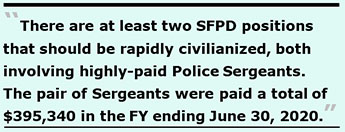 A possible solution: There are at least two SFPD positions that should be rapidly civilianized, both involving highly-paid Police Sergeants.
A possible solution: There are at least two SFPD positions that should be rapidly civilianized, both involving highly-paid Police Sergeants.
The first involves Sgt. Michael Andraychak, the Officer-in-Charge-of SFPD’s Media Relations Unit and SFPD’s spokesperson. He was paid a total of $215,186 (excluding fringe benefits) in the year ending June 30, 2020, including $33,350 in overtime pay and $24,371 in so-called “Other Pay.” There are likely additional sworn officers staffing SFPD’s Media Relations units the Police Commission — if not the Board of Supervisors — might consider civilianizing.
The second involves Sgt. Stacy Youngblood, Secretary to the Police Commission. He was paid a total of $180,153 (also excluding fringe benefits) in the year ending June 30, 2020, including $19,065 in overtime pay and $4,350 in “Other Pay.”
Between Andraychak and Youngblood, the pair of Sergeants were paid a total of $395,340 in the year ending June 30, 2020, including a whopping $52,595 in combined overtime pay. [The pair may have been paid substantially more in the fiscal year that just ended on June 30, 2021.] Surely the two men could be replaced by civilians and returned to performing sworn officer duties (say, foot patrols or larceny thefts, aggravated assault, and robbery investigations).
While the Police Commission has made a commendable start in beginning to develop methodologies the Police Chief should follow in future years, the Commission has a lot of work yet to do to meaningfully address SFPD’s sworn officer staffing.
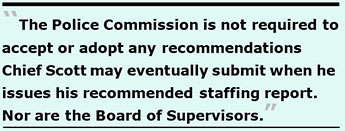 Again, the Police Commission might remember that one red herring is the notion reductions to SFPD’s sworn police officer staffing must be done using a 1:1 ratio of replacing police officers with civilian counterparts.
Again, the Police Commission might remember that one red herring is the notion reductions to SFPD’s sworn police officer staffing must be done using a 1:1 ratio of replacing police officers with civilian counterparts.
“Prop. E” specifically noted that the Commission is not required to accept or adopt any recommendations Chief Scott may eventually submit when he issues his recommended staffing report. Nor are the Board of Supervisors.
Should the Police Commission and City Supervisors flex their collective muscles?
Monette-Shaw is a columnist for San Francisco’s Westside Observer newspaper, and a member of the California First Amendment Coalition (FAC) and the ACLU. He operates stopLHHdownsize.com. Contact him at monette-shaw@westsideobserver.com.